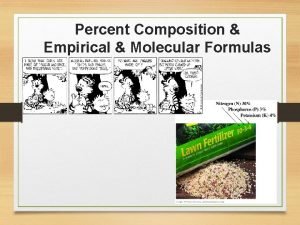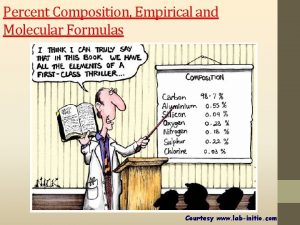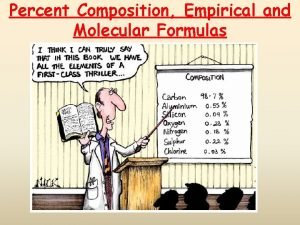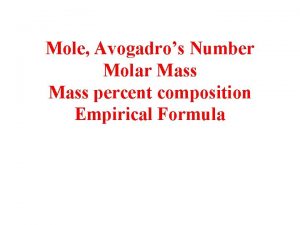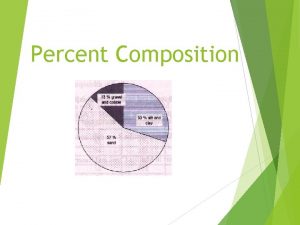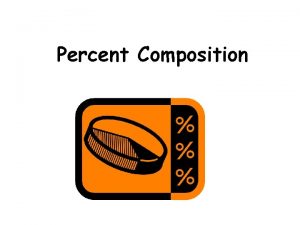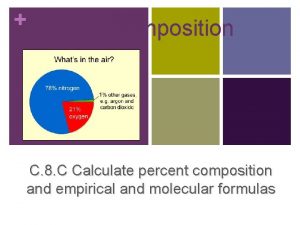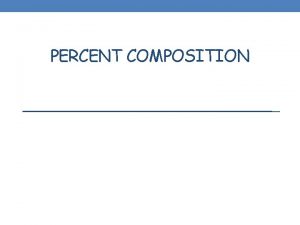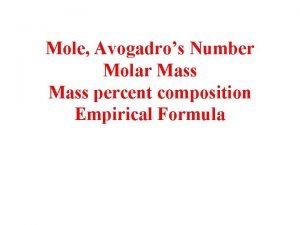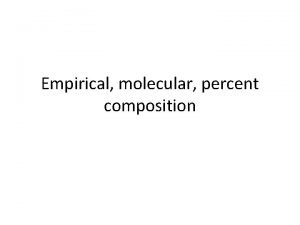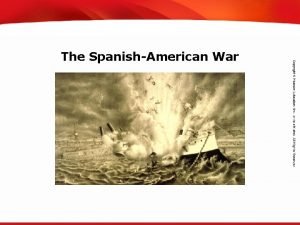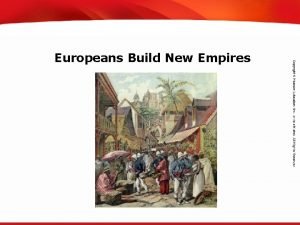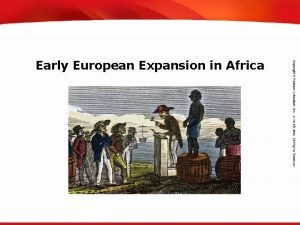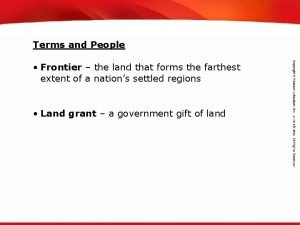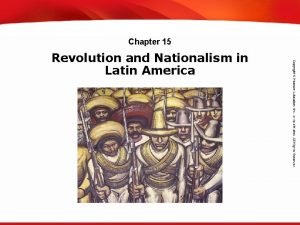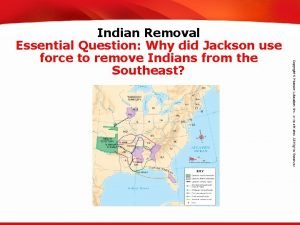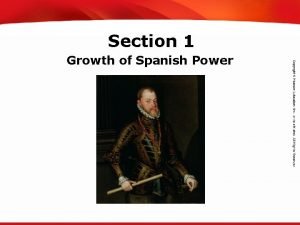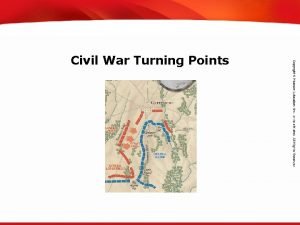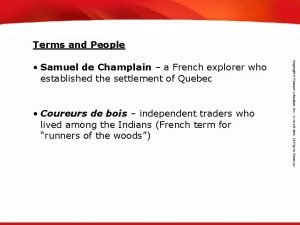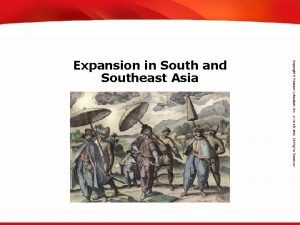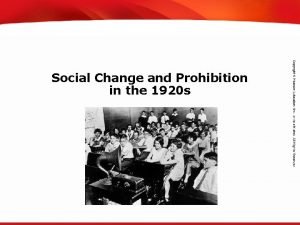TEKS 8 C Calculate percent composition and empirical


















- Slides: 18

TEKS 8 C: Calculate percent composition and empirical and molecular formulas. Africa and the Slave Trade

TEKS 8 C: Calculate percent composition and empirical and molecular formulas. Objectives • Describe the development and cultural characteristics of West Africa in the fifteenth century. • Summarize the events that led to contact between Europeans and West Africans. • Explore the roots of the system of slavery practiced in the Americas.

TEKS 8 C: Calculate percent composition and empirical and molecular formulas. Terms and People • Ghana − prominent kingdom in West Africa, known for its wealth and trade in gold, lasting from A. D. 800 to A. D. 1050 • Mali − West African empire lasting from 1200 to the 1400 s that prospered from the gold trade • Mansa Musa − king of Mali in the early 1300 s who expanded the kingdom’s domain, increased the role of Islam, and promoted scholarship • Songhai − large West African empire lasting from 1460 to the 1600 s

TEKS 8 C: Calculate percent composition and empirical and molecular formulas. What was life like in West Africa before the age of European exploration? The early civilizations of West Africa grew into great trading empires with rich and varied cultures. Trade between West Africans and Europeans—including trade in slaves —would shape the future of both peoples for years to come.

TEKS 8 C: Calculate percent composition and empirical and molecular formulas. West Africa is a land of varied geographic features. • The Sahara is a vast desert that dominates the northern part of West Africa. • A broad savanna lies to the south of the desert. • A lush region watered by the Niger and Senegal rivers lies to the south of the savanna. • Valuable natural resources such as gold and salt are found in West Africa.

TEKS 8 C: Calculate percent composition and empirical and molecular formulas. A thriving trade in commodities such as gold and salt promoted the growth of trading towns. Trading towns eventually grew into great and powerful empires. • Ghana • Mali • Songhai • Other, smaller kingdoms These empires dominated trade routes that linked West Africa with North Africa, the Mediterranean, and Asia.

TEKS 8 C: Calculate percent composition and empirical and molecular formulas. West African Kingdoms, A. D. 800–A. D. 1600 Trade promoted rich and thriving cultures.

TEKS 8 C: Calculate percent composition and empirical and molecular formulas. The earliest kingdom, Ghana, supplied much of the gold for the Mediterranean region by the eleventh century. A thriving caravan trade with African peoples across the Sahara to Morocco resulted in extensive Muslim influence in North Africa. • Ghana had large towns, a system of commerce, and a complex political structure. • Attacks from outsiders eventually weakened Ghana’s control of trade.

TEKS 8 C: Calculate percent composition and empirical and molecular formulas. Around 1200, Ghana was supplanted by a new kingdom, known as Mali. • Mansa Musa, who reigned in the early 1300 s, expanded Mali’s domain. • His promotion of Islamic scholarship led to the founding of the famous university at Timbuktu. • The kingdom of Mali weakened after Mansa Musa’s death in 1332. This medieval map shows Mansa Musa on his throne.

TEKS 8 C: Calculate percent composition and empirical and molecular formulas. By the 1400 s, the Songhai empire emerged. Education and Trade Conquest • Songhai sustained an Islamic system of education based at the capital Timbuktu. • Like Ghana and Mali, Songhai grew rich from trade. • In 1468, Songhai conquered Mali. • As a result, Songhai became the largest and most powerful kingdom in West Africa.

TEKS 8 C: Calculate percent composition and empirical and molecular formulas. West African Trade Routes, A. D. 800–A. D. 1600

TEKS 8 C: Calculate percent composition and empirical and molecular formulas. West African societies were diverse. • Traditional beliefs revolved around the spirit world and the influence of ancestors. • Islam came to have a strong influence. • Land belonged to extended kinship networks. • People often farmed the land in common and divided the harvest. Spiritual Beliefs Land

TEKS 8 C: Calculate percent composition and empirical and molecular formulas. Slavery was common in West Africa, and human beings were often used as items of trade. The slave trade was an important part of West Africa’s economy. West African rulers sold about 1, 000 slaves annually to Arab traders, who took them to the Mediterranean.

TEKS 8 C: Calculate percent composition and empirical and molecular formulas. West African slavery had developed as a system with its own characteristics. • It was not based on racial superiority or inferiority. • Prisoners of war and criminals often became slaves. • Slaves were usually adopted by their owners, and their children usually did not inherit slave status. • Slaves could become wealthy, important officials and soldiers.

TEKS 8 C: Calculate percent composition and empirical and molecular formulas. Throughout the 1400 s, the Portuguese explored farther south along the West African coast. Initially, they acted as pirates, seizing gold, pepper, and slaves. But African resistance soon forced the Portuguese to shift to trading.

TEKS 8 C: Calculate percent composition and empirical and molecular formulas. In time, the Portuguese established a profitable trade with the West Africans. The Portuguese exported peppers, ivory, copper, and African slaves. In this way, Europeans first became involved in the long-standing slave trade of Africa.

TEKS 8 C: Calculate percent composition and empirical and molecular formulas. The Portuguese greatly expanded the slave trade. By 1500, Europeans purchased about 1, 800 African slaves a year, nearly doubling the trade between the West Africans and the Arabs. • Some slaves were shipped to Europe. • Most worked on sugar plantations on islands in the East Atlantic. • Growing numbers went to new plantations in the Americas.

TEKS 8 C: Calculate percent composition and empirical and molecular formulas. Over the next centuries, more than one million men and women would be taken from West Africa and sold into slavery in the Americas.
 How to calculate empirical formula using percentages
How to calculate empirical formula using percentages How to calculate empirical formula with percentages
How to calculate empirical formula with percentages Molecular mass of potassium permanganate
Molecular mass of potassium permanganate Empirical formula from percent composition
Empirical formula from percent composition Empirical formula from percent composition
Empirical formula from percent composition How to calculate empirical formula using percentages
How to calculate empirical formula using percentages How to find molecular formula
How to find molecular formula How to get empirical formula from percentages
How to get empirical formula from percentages How to calculate percentage by mass
How to calculate percentage by mass How to find mass percent
How to find mass percent How to find percent composition
How to find percent composition How to calculate valid percent
How to calculate valid percent Percent composition of m&m lab
Percent composition of m&m lab A part of a whole is
A part of a whole is Definition of percent composition
Definition of percent composition Percent by mass
Percent by mass Percent composition examples
Percent composition examples Percent composition of nitrogen
Percent composition of nitrogen Percent by mass formula
Percent by mass formula

